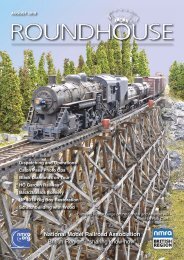NMRA RH October 2018
Create successful ePaper yourself
Turn your PDF publications into a flip-book with our unique Google optimized e-Paper software.
The next part added was the Ridgeway<br />
or “Bear Trap” cinder catcher<br />
that I had already airbrushed flat<br />
black. It took some fussing with to<br />
shape the down pipe to fit my loco,<br />
after which it was glued to the top of<br />
the stack with CA. This Nn3 part, like<br />
the plow was a bit short with the cinder<br />
pipe not going down far enough.<br />
I simply glued a piece of a toothpick<br />
to the front of the cylinders and painted<br />
it flat black to match. This is one<br />
of my favorite detail parts.<br />
After this I added mullions to the front<br />
cab windows which were cut out of<br />
a Grandt Line engine house window,<br />
painted red to match the existing cab<br />
window trim and then carefully glued<br />
in with CA. The last detail part added<br />
to the locomotive itself was some<br />
feed water pipes. This loco was a bit<br />
lacking on external piping details so I<br />
thought these would add to it.<br />
For the tender I added a small air<br />
tank and piping on the back like the<br />
C&S #9. This part too was airbrushed<br />
flat black before it was applied. I’ve<br />
always liked tender doghouses on<br />
narrow gauge locomotives, and<br />
although the C&S #9 did not have<br />
one, my brakemen were complaining<br />
so I gave in. This little doghouse was<br />
entirely scratch built from building kit<br />
scraps with a bit of wire for handrail<br />
details. It was painted flat black with<br />
acetone “glass” added in the windows.<br />
Now my brakemen can get<br />
out of the weather and stop complaining!<br />
Detailing the 4-6-0 Ten Wheeler<br />
I did not have a real prototype in<br />
mind for this locomotive so only a<br />
few details were added. I did decide<br />
to add a homemade spark arrestor<br />
much like those found on the<br />
Durango and Silverton’s locomotives.<br />
Some fine screen, which I also got<br />
from Republic Locomotive Works,<br />
was cut in a narrow strip test fitted<br />
to the circumference of the smoke<br />
stack and cut to length. I glued it<br />
together with a tiny bit of CA using<br />
reverse tweezers as a clamp. While<br />
that was setting, I cut a tiny circle of<br />
screen using a bamboo skewer as<br />
a guide. This was glued on the top<br />
of the mesh ring and then the whole<br />
thing was glued to the top of the<br />
stack. Next I cut another tiny strip of<br />
painter’s tape and wrapped it around<br />
the top of the stack to hide the joint<br />
between the screen and stack.<br />
Lettering and Re-lettering<br />
First I had to remove any factory<br />
lettering. Both USRA short tenders<br />
came lettered for Union Pacific. To<br />
remove the factory lettering I used<br />
a small piece of paper towel soaked<br />
in Micro Sol and brushed periodically<br />
to keep it moist. After about 5<br />
minutes I used an eraser to rub off<br />
the factory lettering. Custom decals<br />
were required since I had decided to<br />
do my own “faux narrow gauge” line.<br />
Through a Facebook connection, I<br />
found Russell at Red River Models.<br />
I designed a whole sheet of lettering<br />
for locomotives and rolling stock, and<br />
Russell printed them out. His work is<br />
outstanding so be sure to contact him<br />
if you need custom decals. I added<br />
my road name, Silver Creek Northern,<br />
to the Ten Wheeler’s tender and<br />
the number 12 to the back. On the<br />
locomotive, I added numbers to the<br />
cab, sand dome and headlight. I also<br />
added “SCN” in tiny letters to the<br />
bottom of the cab. While I did not use<br />
it as a prototype, Tweetsie Railroad’s<br />
(former ET&WNC) #12 was the inspiration<br />
for the Ten Wheeler’s number.<br />
Later 4-6-0 locomotives will follow<br />
the ET&WNC’s numbering scheme.<br />
Once the decals were applied I over<br />
sprayed the locomotives with Testor’s<br />
Dull Cote.<br />
Weathering<br />
I had actually been stressing about<br />
this quite a bit and finally decided<br />
to order Doc O’ Brien’s weathering<br />
powders from Micro Mark. These<br />
worked great and were easy to use.<br />
I added rust spots to fittings, streaking<br />
to the boiler and tender, sand/dirt<br />
to the running gear and tender trucks<br />
and other general grime. Then, I over<br />
sprayed it again with Testor’s Dull<br />
Cote. This really diminishes the color<br />
of the weathering powders but, the<br />
good news is, more weathering powders<br />
can by applied. When viewed up<br />
very close, the locos almost look over<br />
weathered but when standing back<br />
to a normal viewing distance, I think<br />
they look pretty good. Also, I forgot to<br />
mention that both locomotives got an<br />
engine crew from Woodland Scenics.<br />
Final Thoughts<br />
All in all, this was a great learning<br />
opportunity for me, and has given me<br />
the confidence to try other customizing<br />
projects. My little “faux narrow<br />
gauge” line is going to be quite a<br />
unique railroad.<br />
Jason Stamper<br />
<strong>October</strong> <strong>2018</strong> - ROUNDHOUSE 25



